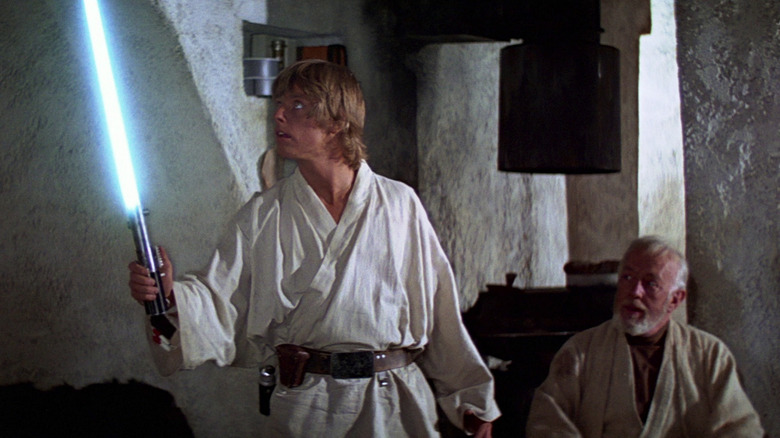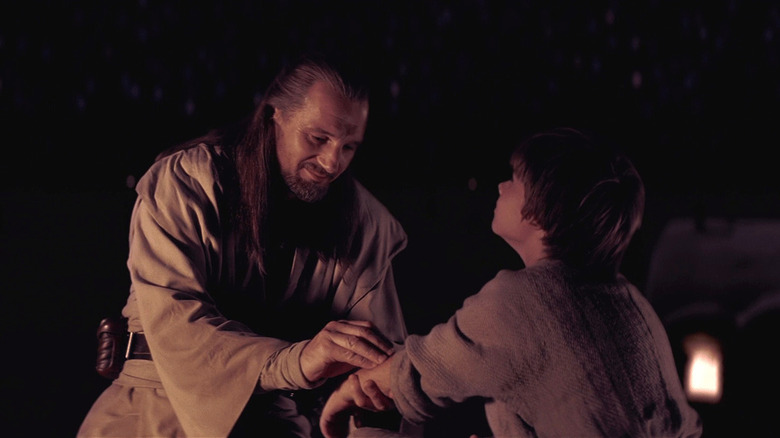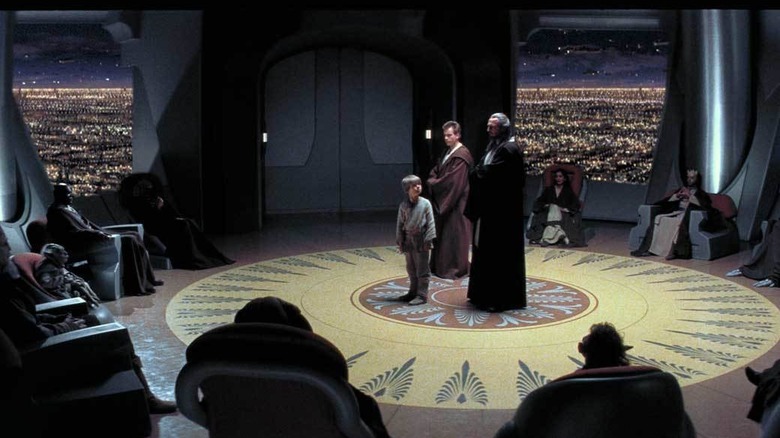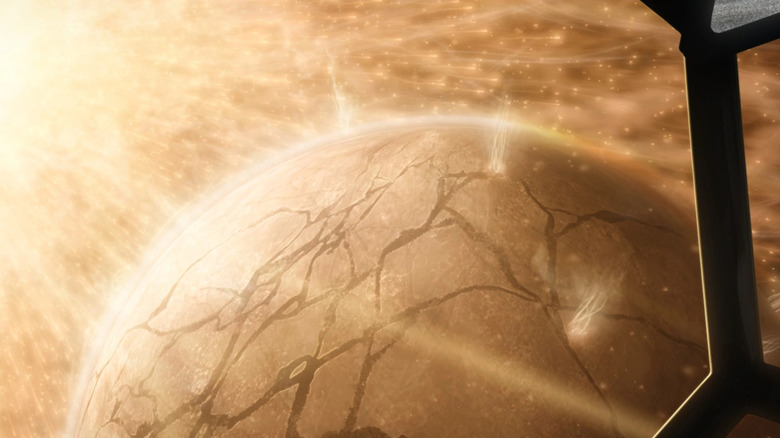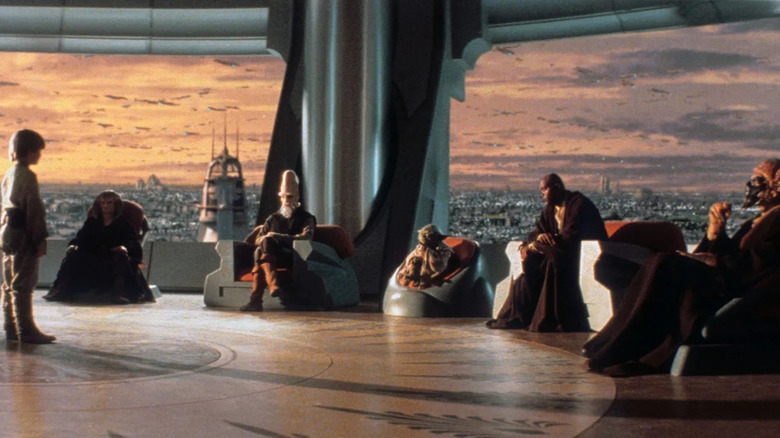George Lucas' Most Controversial Addition To The Star Wars Prequels Was There The Whole Time
Midi-chlorians are a microscopic life form. They're also misunderstood by many and the thing that made some "Star Wars" fans think the Force was strictly a matter of science rather than mysticism, turning them off the franchise altogether.
In 1999, when "Star Wars: Episode I — The Phantom Menace" was released, the concept of midi-chlorians was hotly debated, with fans wondering what was going on and why "Star Wars" creator George Lucas had "changed the Force." However, further investigation shows that midi-chlorians aren't the Force-killer some people believed they are. Nor, for that matter, were they some last minute addition to the mythology of "Star Wars" or the Force. In fact, if you go back to pre-production on what would become "Star Wars: Episode IV — A New Hope," you'll find they were already on Lucas' mind back when he was first imagining life in a galaxy far, far away.
Master Qui-Gon, what are midi-chlorians?
When Anakin Skywalker (Jake Lloyd) asks Jedi Master Qui-Gon Jinn (Liam Neeson) about midi-chlorians in "The Phantom Menace," he gets a fairly detailed response:
"Midi-chlorians are a microscopic life form that resides within all living cells .... and we are symbionts with them ... life forms living together for mutual advantage. Without the midi-chlorians, life could not exist and we would have no knowledge of the Force. They continually speak to us, telling us the will of the Force. When you learn to quiet your mind, you'll hear them speaking to you."
For many, this explanation was troubling. Did that mean the strength of the Force inside you was dependent on things other than your belief in the Force? To a point. Dave Filoni — now the Chief Creative Officer at Lucasfilm — broke it down thusly in a 2016 interview:
"For a long time I've used someone like Bruce Lee as an example. He has, if you like, a lot of talent for martial arts — or a very high midi-chlorian count. If I train in martial arts, can I learn martial arts? Yes. I can improve my midi-chlorian count in that discipline. Will I be as good as Bruce Lee? No, that's not my talent. We were always able to find real-world equivalencies to 'Star Wars' to make comparisons that make it feel like it's a real thing."
If one breaks down what Qui-Gon actually says, it makes perfect sense. Everyone has midi-chlorians, meaning everyone has the ability to be influenced by the Force or somehow manipulate it. This is wholly consistent with Obi-Wan's explanation of the Force to Luke in "Star Wars: A New Hope" (emphasis mine): "The Force is what gives a Jedi his power. It's an energy field created by all living things. It surrounds us, it penetrates it. It binds the galaxy together."
All living things have the Force flourishing through them, and that comes in the form of midi-chlorians.
George's interest
George Lucas has often talked about his interest in the idea that there are more microorganisms inside of a human than there are human cells. And it was this interest in mitochondria and other organisms that influenced the creation of the Force in his mind. Going back to early story notes for "A New Hope" and transcripts of conversations Lucas had to unify the mythology amongst his crew, you can see it. Tucked away in JW Rinzler's brilliant and exhaustive tome "The Making of Star Wars," there's a small aside with Lucas talking about the mysteries of the Force in the mid-1970s and it is very much in line with Dave Filoni's Bruce Lee explanation:
"It is said that certain creatures are born with a higher awareness of the Force than humans. Their brains are different; they have more midi-chlorians in their cells. The Force is a perception of the reality that exists around us. You have to come to learn it. It's not something you just get [...] The Force is always there, however. Anyone who studied it and worked hard could learn it, but you would have to do it on your own."
Lucas later added that "Midi-chlorians were a loose depiction of mitochondria, which are necessary components for cells to divide. They probably had something — which will come out someday — to do with the beginnings of life and how one cell decided to become two cells with a little help from this other little creature who came in, without whom life could not exist. And it's really a way of saying we have hundreds of little creatures who live on us, and without them, we all would die."
Though there were some reports that Lucas had the transcript of his notes changed to reflect the inclusion of midi-chlorians, even the original trilogy DVD commentaries have Lucas hinting that he had considered including them as far back as "A New Hope" (although the idea wouldn't officially debut until 1999).
Why introduce them in The Phantom Menace?
There are a number of reasons George Lucas might have felt the time was right to include the concept of midi-chlorians in "The Phantom Menace." Chief among them was that it was an easy narrative device to show off how exceptional Anakin Skywalker was. From an audience perspective, it helps us understand how much potential the boy has when Obi-Wan says in awe, "Even Master Yoda doesn't have a midi-chlorian count that high."
Since we have this connection to Yoda as the most powerful Jedi we've ever seen, we apply Obi-Wan's awe-struck line delivery to our own wonder and it gives us an easy, numerical benchmark to tie to Anakin's power level. The other reason is clearly to add other layers to the Force, especially from a Jedi Order that's been losing its way and would, within the next decade, step into the war that would end them. Focusing on the science of their spirituality seems like a good way to divorce yourself from your faith and couch it in terms of science. The Sith seem to have no use for midi-chlorians — except for Palpatine heavily implying that they used them to actually create Anakin.
The Wellspring of Life
George Lucas expanded his theory about midi-chlorians and their connection to real world mitochondria even further when he had the chance, specifically with the animated series "Star Wars: The Clone Wars." The show's seventh season episode "Destiny" takes Yoda to a mysterious Force planet that the Force priestesses refer to as the Wellspring of Life. There, they explain to Yoda exactly what that place is:
"All that surrounds us is the foundation of life, the birthplace of what your science calls midi-chlorians, the foundation of what connects the Living Force to the Cosmic Force."
You can see clearly where Lucas is connecting the idea of the Force to mitochondria through midi-chlorians. Instead of taking way the mysticism of the Force, as some claim, it really feels like it deepens the mystery in exactly the way Lucas intended.
Love 'em or hate 'em
Whether you love the concept of midi-chlorians (as I do) or hate them, there's no arguing that they weren't just thrown into "Star Wars" without thought. They were a carefully crafted piece of the lore from the creator of "Star Wars" and offer a fascinating window into Lucas's spirituality and the mythology he brought the world.
For fans in 1999, midi-chlorians might have seemed a surprise (and to a few a slap in the face), but those of us in this day and age know better, and the nuances of this mythology continually give us gift after gift. Take, for example, Sabine Wren's use of the Force in "Ahsoka," which is completely in line with the mythology George Lucas established on day one.
It's extraordinarily rare when "Star Wars" contradicts itself, but when it comes to the Force, there has only ever been a rich deepening of the mystery. All we have to do is approach the narrative with curiosity and wonder, rather than skepticism and doubt.
Perhaps curiosity and wonder are the midi-chlorians of enjoying films. When you learn to quiet your mind of the combative skepticism and doubt, you'll hear films and their nuanced details speaking to you.
